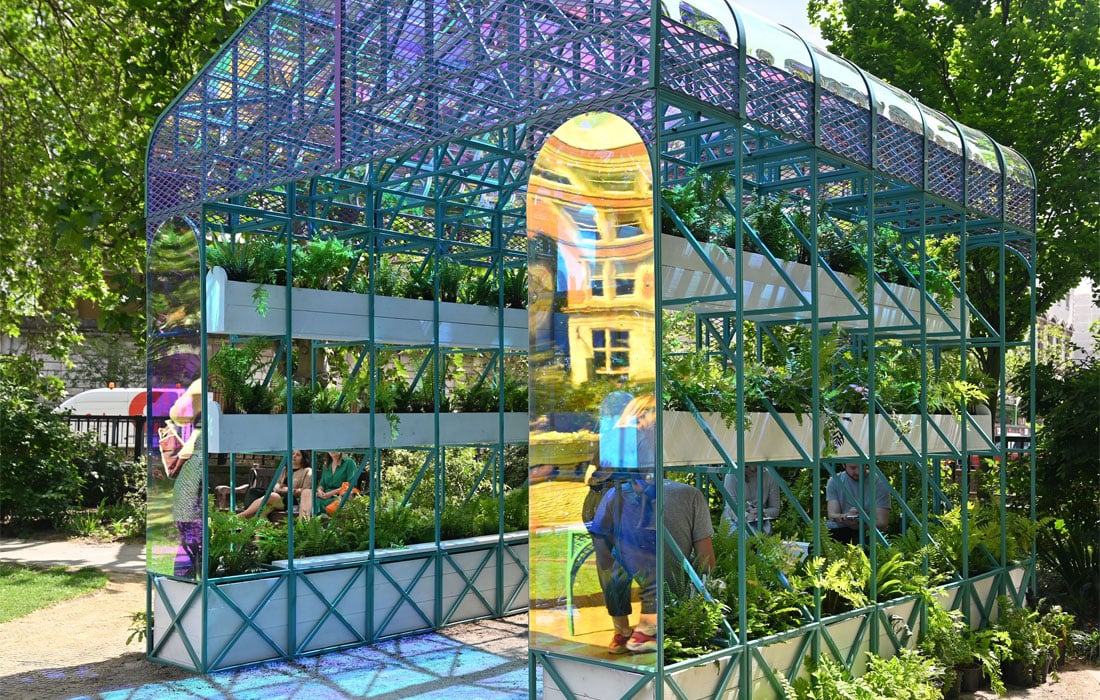
The House of Wayward Plants: The Smithfield Greenhouse, as part of Culture Mile’s Play the Mile
Photo: Mark Allan
Redefining the City of London through culture
The global finance hub is forging a new identity through risk-taking alliances between its commercial, public and cultural sectors, writes Tim Jones.
The use of the term ‘placemaking’ by architects, landscape designers, creative agencies, developers, community groups, marketing agencies, as well as by the cultural sector, has exploded in recent decades. When a term becomes so widely adopted in a short space of time it’s natural to be cynical, but I predict that the phrase isn’t going anywhere fast, for two reasons.
Cultural placemaking, done well, pulls everyone out of their silos and into new relationships, working together to take risks and come up with new approaches
First, the word’s ubiquity creates a bigger and more diverse conversation around a core idea. And it’s a huge conversation in which we’re all entitled to participate. How do we make and remake places (rather than spaces)? What are the characteristics of a successful place? Who decides? Are places created consciously or do they emerge? Who is practically involved? How are places maintained? How do they evolve? Are there winners and losers during the process? If so, how can this be avoided?
The second reason is that our collective understanding of ‘what culture is’ is very different from what it was even a generation ago. Research in the US from LaPlaca Cohen’s 'Culture Track' initiative makes this plain. More of us than ever consider ourselves culturally engaged, and we are now expanding the definition of culture “possibly to the point of extinction”. ‘Big c’ and ‘small c’ culture now intermix with a day-to-day theatricality that we all welcome, and the stage for this activity is places, from small community-owned plots to large brownfield regeneration sites, where these elements can be brought together in ways that benefit a range of communities and tell great stories.
New cultural district
Culture Mile is the cultural district launched in 2017 by the City of London Corporation, in partnership with the Barbican Centre, the Guildhall School of Music and Drama, the London Symphony Orchestra and the Museum of London. Together we are committed to transforming the north-west of the Square Mile and redefining the City of London as a global leader in culture.
We are leveraging the programming expertise from our cultural partners, such as our recent collaboration with the Barbican on its 'Sound Unbound' weekend, which connected classical and experimental music performances across the district to a fresh, hungry audience. But we must also work on an expanded canvas if we are to respond to how our communities and audiences want to experience culture. Sound Unbound was the launch event for our current 'Play the Mile' season, which is celebrating the power of creativity in everyday life.
The risk when working with a broad palette is that it can lead to an unfocused offer. So we are working hard to create a unified and ambitious identity as a cultural district through applying a set of principles we can unite our public-facing content under. We can then stand out from other districts through our distinct and differentiated offer.
We have no shortage of fuel for developing these ideas. As well as a cluster of world-class cultural organisations, we have a 2,000-year history to play with, as well as superb connectivity, which will only be enhanced when the Elizabeth Line is completed. But my experience is that places large and small, urban and rural, can apply similar approaches and leverage the power of arts and culture to develop the quality of experience that we want to enjoy in them.
Unexpected connections
With our radically broad application of the word ‘culture’ comes an opportunity to assert the relevance of cultural and artistic expertise into sectors that may have previously paid little attention to them. Great placemaking connects stakeholders, sectors and economies, and builds broad-based coalitions that unite the interests of the commercial and public sectors, as well as the needs and objectives of the cultural sector.
We are on the road to this goal at Culture Mile, with our growing network of over 30 organisations across academia, arts, finance, property, health and wellbeing, hospitality and beyond – uniting because they see clear shared benefit in a culture-led approach to the area’s revitalisation.
Cultural placemaking, done well, pulls everyone out of their silos and into new relationships, working together to take risks and come up with new approaches. Commercial, cultural and civic sector players will have different agendas, but all want places to be successful. The networks created by these projects should share learning and take the time to understand everyone’s expertise and strategic objectives. They should support participants to understand and influence how arts and culture can be relevant.
Cultural placemakers need to be expert befrienders and collaborators, good at striking up unusual alliances. I’ve learnt to be comfortable with the unease that accompanies a constantly expanding professional comfort zone, to sharpen my elbows to get to tables where decisions are being made, to be open to experimentation, to learn the language and rhythms of other sectors (equally prone to baffling jargon, acronyms and territorialism), to be persistently curious about everything, and fundamentally, to work on the basis of the Culture Track insights.
We have all decided that culture is deeply relevant to our lives. Those of us working in the culture sector should meet the public where they are and show how we can respond by creating great places that reflect this truth.
Tim Jones is Culture Mile Manager at the City of London Corporation.
www.culturemile.london/
Join the Discussion
You must be logged in to post a comment.